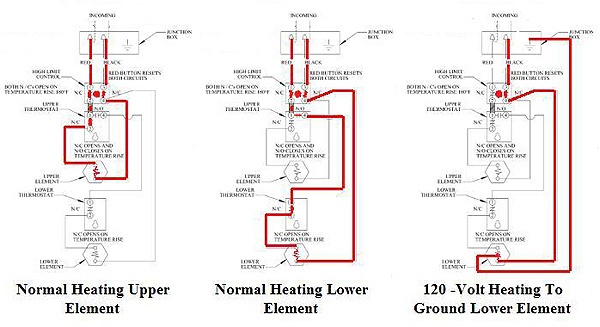 Gas or Electric Heater Fails to Heat Water
Gas or Electric Heater Fails to Heat WaterIf your gas heater isn't getting the water up to the right temperature try the following simple steps:
• Check that the gas is switched on. Move the gas control to 'pilot' to ensure that the burner doesn't ignite whilst you're inspecting the interior. Take off the metal cover from the bottom of the heater and see if the burner or pilot light is lit.
• If the pilot light is not lit, relight it. It's possible that the inlet valve for the gas has been closed partway or completely. If this is the case, turn the handle parallel to the line and re-ignite the pilot light. If you can't get the pilot to light, it could be the thermocouple that's damaged and you should give up your DIY troubleshooting of the water heater and phone the gas utility company or a plumbing repair person.
• If the burner is not lit, put back the metal cover and check that the thermostat is set at approximately 120ºF. If not, reset it and turn on the hot water tap for a couple of minutes to check if the burner ignites. If it doesn't, leave the hot tap running and try moving the temperature dial down and then up to make the burner ignite.
• If it's the burner lights, put back the cover and set the thermostat to a suitable temperature. However, if it doesn't ignite, stop all water heater troubleshooting activities and get an expert repair person to look at it. It's possible the thermostat is defective. Replacing a thermostat is a job for an expert in this type of plumbing problems.
• Sniff the air for any traces of gas. If you detect a garlicky smell, turn the gas valve control to 'off'. Do not relight the pilot light until the smell of gas has completely disappeared. If the smell of gas is strong and doesn't diminish, turn the gas supply valve off straightaway, open windows and doors and leave the building. Contact the utility company from a location away from your home and leave the water heater troubleshooting to the experts.
If your Electric Water Heater isn't getting the water up to the required temperature it means that the power supply to the heater has been interrupted or you have a problem with heating elements or controls.
• Check that the electric current to the appliance is working. Look at the water heater's main switch and check the circuit breaker serving the heater. If the circuit breaker has been tripped, you can easily troubleshoot the water heater. Reset it by moving it first to the 'off' position and then the 'on' position.
• If you've got a blown fuse, put in a replacement of the same rating. In circumstances where you get repeated blown fuses or tripped circuit breaker, phone a qualified electrician to repair the circuit. Always make sure that the water heater doesn't share the circuit with another appliance because it takes too much power when heating up the water.
• Take a look at the high temperature cutoff in the heater. Open up the panel and press the reset button. If you don't hear a click or you continue without power after pressing it, this means that the high temperature cutoff is probably broken. Contact an electric water heater repair person.
• If you see water inside the panel it may be that which has made the thermostat stop working properly. If there is a water leak then you'll have to replace the heater and no amount of water heater troubleshooting will save it!
• If these suggestions don't lead to a solution of the problem it may be that there's a problem with the heating elements. If you know what you're doing with this type of repair, troubleshoot the water heater yourself by following the manufacturer's instructions on how to replace heating elements. Otherwise, contact an electric water heater expert.